Heading out the door? Read this article on the new Outside+ app available now on iOS devices for members! Download the app.
A little wider, more playful, and floatier than your traditional all-mountain skis, the all-mountain wide category is built for the soft stuff. Not that the winners here don’t enjoy trenching on groomed—they do—but they like to dive into the woods as much as possible before getting back to the lift.
In this category, we’ve seen more brands prioritize ease and forgiveness, scaling back on metal laminates and steepening the rocker in the tips and tails for a friendlier, more encouraging shape.
Because this category is meant for those boot-top fluff days, we’ve weighted the scores to reward versatility, crud performance, and flotation over all else. The winners from our 2024 SKI Test at Mt. Rose, Nevada, are ideal everyday drivers for Westerners—and specialty boards for Right Coasters for when the Nor’easters blow in.
Editor’s note: The skis on this page appear in ranked order, with the highest-scoring ski appearing at the top of the list. While we’re big fans of the Rossignol Rallybird Soul 102 and think it sets the benchmark for what a women’s all-mountain wide ski should do, remember that testing skis is somewhat subjective. While our crew of lady testers deemed this ski the best of the best, it might not necessarily be the best choice for every type of skier. So don’t just pay attention to scores and rankings—dig into each review to learn about a ski’s strengths and weaknesses. Otherwise you might end up with a great ski, just not the right ski for you.
Check out the best unisex all-mountain wide skis here.
At a Glance
- Best in Test: Rossignol Rallybird Soul 102 ($700)
- Most Forgiving: Salomon QST Stella 106 ($750)
- For Moguls and Tree Skiing: Fischer Ranger 102 ($850)
- For Chargers: Nordica Santa Ana 102 ($850)
- For Soft Snow: blackcrows Atris Birdie ($849)
- For Crud: Völkl Secret 102 ($850)
- Blizzard Sheeva 10 ($800)
- Head Kore 103 W ($749)
- Armada ARW 106 ($750)
- K2 Mindbender 106C W ($700)
If you buy through our links, we may earn an affiliate commission. This supports our mission to get more people active and outside. Learn more.
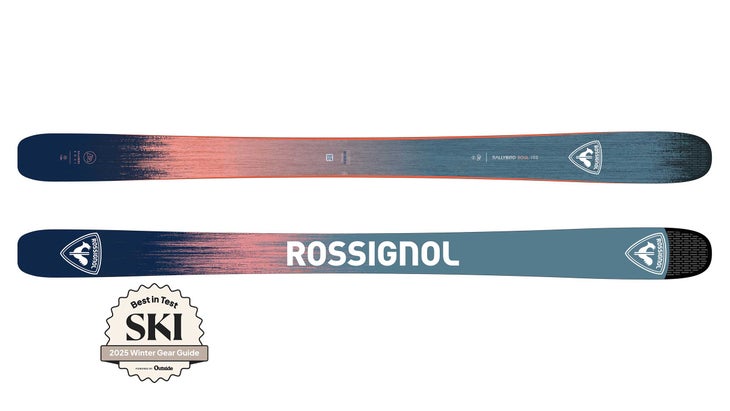
1. Best in Test
Rossignol Rallybird Soul 102
$700 at Evo $700 at Ski Essentials
Score: 8.02/10
Dimensions: 135-102-125 mm
Lengths: 150, 156, 164, 172 cm
Turn Radius: 16 m (172 cm)
Weight: 1,700 g (172 cm)
Pros and Cons
⊕ Supremely versatile
⊕ Energetic yet stable
⊕ Available down to 150 cm length
⊗ Not the most reliable on hardpack
The lovechild of the young Rallybird and the old Soul 7 (albeit, with its own modern shape), this versatile new hybrid is as hard-charging as the former and as approachable as the latter. Of the 13 all-mountain wide skis we tested at Mt. Rose, Nevada, testers ranked the Rallybird Soul 102 No. 1 in versatility, playfulness, and responsiveness, and No. 2 in forgiveness and crud—the most important criteria in this category.
It’s a gifted polymath, knowing exactly how to handle every terrain type and ability level, and will back off or ramp up according to skier input. It also has a huge sweet spot, which means it won’t run screaming into the woods if you find yourself in the backseat.
The Rallybird Soul 102 combines the general shape of the Rallybird 104, which has a raised tail for ease of exit in turns, with tech that made the legendary Soul 7 so forgiving, like the vibration damping rubber pad in the core. Just the right amount of metal underfoot offers enough edge grip for cruising or charging groomers.
Is it perfect? Well, testers did note it prefers soft snow, but that’s not much of a complaint considering the category. SKI’s test director Jenny Wiegand summed up why this ski made the top of testers’ lists: “It’s hard to find a ski that can charge but also take it easy on you.”
Read our full review of the Rossignol Rallybird Soul 102.
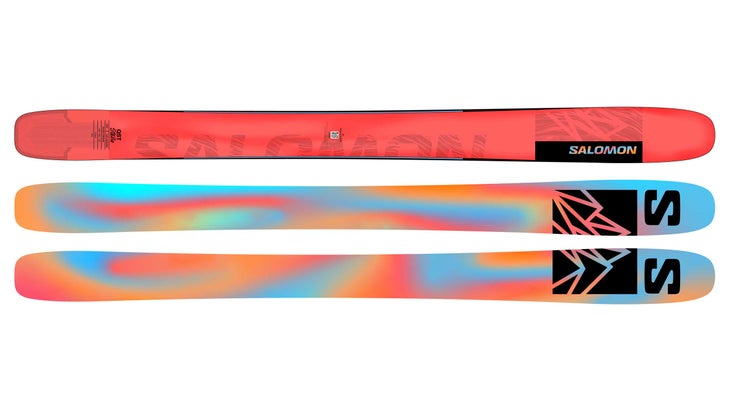
2. Most Forgiving
Salomon QST Stella 106
Score: 7.57/10
Dimensions: 137-106-124 mm
Lengths: 157, 165, 173 cm
Turn Radius: 17 m (165 cm)
Weight: 1,810 g (165 cm)
Pros and Cons
⊕ User-friendly
⊕ Confidence-inspiring
⊕ Forgives mistakes
⊗ Deflects in crud
⊗ Prefers soft snow
The QST Stella 106 is the ultimate adventure partner—she’s always up for anything and has a positive attitude no matter what mishaps occur. Testers noted this ski is friendly, playful, poppy, and easygoing, yet has a great snow connection on groomed and soft steeps.
A poplar wood core keeps the QST Stella 106 light and responsive, and an extra insert of sidewall material underfoot makes it have that stuck-to-the snow feel on hardpack.
The result is a ski that’s confidence-inspiring for intermediates and dependable enough for experts who want to really stand on it. It’s easy to whip around in tight spaces and is so playful that it begs for air time from those who want to send it.
When it comes to shortfalls, skis of this ilk usually prefer surfing fluff to suffering chunder and blue ice, and the Stella 106 is no exception: testers noted that its tip gets kicked around a bit in crud and terrain transitions.
But for women who want a surfy and relaxed ride that’s as comfortable as it is comforting, the QST Stella 106 is a solid choice. “It’s like dancing on clouds,” said longtime tester Kelli Gleason. “This ski guides you through each turn with effortless finesse.”
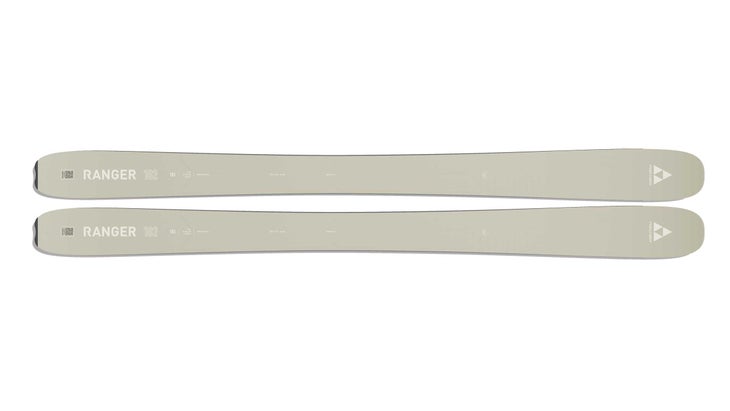
3. Best for Moguls and Trees
Fischer Ranger 102
Score: 7.54/10
Dimensions: 136-101-127 mm
Lengths: 155, 162, 169, 176, 183, 190 cm
Turn Radius: 17 m (169 cm)
Weight: 1,750 g (169 cm)
Pros and Cons
⊕ Quick underfoot
⊕ Responsive to skier input
⊗ A little shy at high speeds
⊗ The tail can make you feel locked in a turn
The gender-specific ski pendulum is swinging back toward manufacturers making one model in a wide-enough size range to cater to both sexes, and when it comes to the unisex Ranger 102, the ladies approve. It won them over with its ability to listen to input and perform accordingly, never pushing its own agenda.
With less metal than its little sister, the Ranger 96, the Ranger 102 is a lighter, surfier, and more energetic ski with agility to spare. In fact, it earned the highest marks in quickness out of all the skis we tested this year. Testers deemed it an accessible, confidence-building tool for intermediates, as well as fun for experts who just don’t want to work too hard.
It was solid in corn, refrozen slush, steeps, groomers, and tight trees, but dipping in and out of bumps is where it really came to life. “Felt like I was on a motorcycle zipping through traffic. Let these skis run, and they’ll show you the best line to take,” said Taos-based tester Erika Northrop.
Some noted the Ranger 102 could feel a little locked into the turn on hardpack due to a strong tail. Others felt it was a little flaky at high speeds. Though to be fair, we only had access to one test length (169 centimeters), and some of our expert women found that was too short for them. The takeaway here: expert ladies looking to charge might want to size up, while those looking for more maneuverability might want to go shorter.
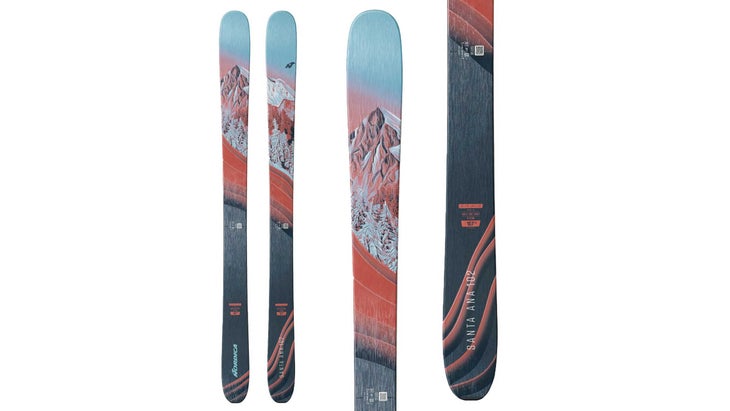
4. Best for Chargers
Nordica Santa Ana 102
$850 at Evo $850 at Ski Essentials
Score: 7.26/10
Dimensions: 129-102-119 mm
Lengths: 155, 161, 167, 173, 179 cm
Turn Radius: 17 m (161 cm)
Weight: 1,825 g (161 cm)
Pros and Cons
⊕ Stable, no matter the speed
⊕ Arcs a turn like a ski half its width
⊗ Lacks liveliness
⊗ Geared toward experts
Nordica has been toying with the recipe for the new Santa Anas for two years, trying to get just the right amount of metal to make it calm and stable, yet not so much that it becomes overly damp and serious. According to testers, the brand certainly succeeded on the calm and stable front—making the Santa Ana 102 a great choice for skiers who want a board they can rely on in any predicament. The only downside: like its predecessor, this year’s version still isn’t exactly poppy or playful.
However, testers did deem it the most loyal, dependable, and steadfast companion for hard-chargers who ski no matter the conditions. Powder, frozen ocean, firm groomers, graupel, mank—bring it on. Winning the category in the stability-at-speed department and earning a No. 2 rank in the hard-snow-integrity criteria, the new Santa Ana 102 goads you into pass-pulling speeds. Testers found it has no limit to what it can do, as long as you’re strong enough to drive it.
While most agreed the new metal laminate and rocker profile does make it more forgiving than its predecessor, the less-skilled among us may find it to still be too burly. But if you get after it, this is your ski. “Aggressive skiers will have the time of their lives, especially on soft snow or blasting through crud,” summed up Bridger Bowl-based tester and Outside editor Kelly Klein.
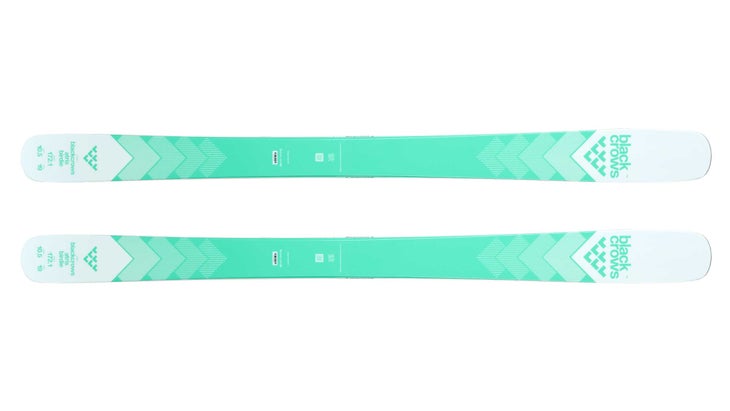
5. Best for Soft Snow
Blackcrows Atris Birdie
Score: 7.09/10
Dimensions: 135-105-122 mm
Lengths: 160, 166, 172, 178 cm
Turn Radius: 19 m (166 cm)
Weight: 1,675 g (166 cm)
Pros and Cons
⊕ Very playful
⊕ Agile in tight spaces
⊗ Not the best tool for firm conditions
⊗ Can get overpowered
This year, blackcrows made some tweaks to its popular Atris Birdie to render the ski both quicker and more playful—and testers were impressed. The new model is a nimble little minx that loves to weave through tight trees and dance through the bumps. “They pivot with very little effort,” reported Utah-based tester Avery Pesce, vice president of merchandising at Boston Ski and Tennis.
In terms of construction, ain’t no metal here—just a wood core and fiberglass laminates—which is why the Atris Birdie feels so light and lively. That’s also, however, why it got dinged for chattering at high speeds and snubbing its nose on true hardpack. It should be noted that some testers raised an eyebrow at the overly sharp ski tune at our test at Mt. Rose, Nevada, which could have impacted its hard-snow scores. Most wished they could have skied it straight out of the wrapper for comparison.
While testers did note that stronger or heavier skiers could overpower the Atris Birdie, they felt its spritely nature made it a good choice for intermediates who don’t want to be bullied and for experts who ski with more finesse than power. “It’s a versatile and friendly ski that can still charge,” said Taos-based tester and Outside editor Abigail Barronian.
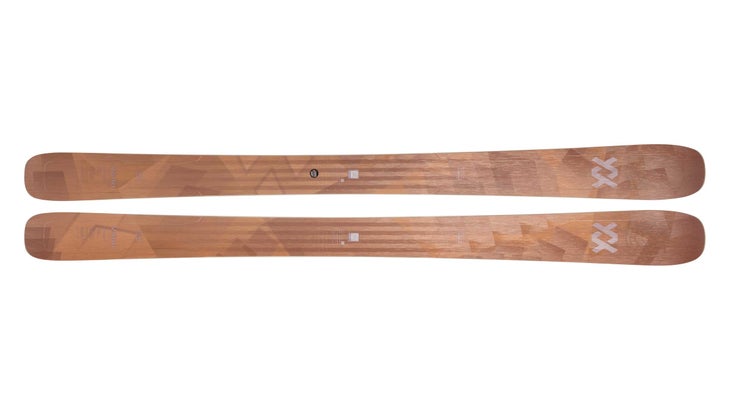
6. Best for Crud
Völkl Secret 102
Score: 6.98/10
Dimensions: 140-102-123 mm
Lengths: 156, 163, 170, 177 cm
Turn Radius: 23-14-21 m (163 cm)
Weight: 2,020 g (170 cm)
Pros and Cons
⊕ Superior edge grip
⊕ Carving machine
⊗ Takes skiing very seriously
⊗ Too precise to forgive mistakes
With the Secret 102, Völkl designers have developed a revolutionary snow magnet that turns like it’s on rails, regardless of what horrors lie beneath its edges. This ski topped the charts in both the crud and hard-snow-integrity criteria, allowing testers to push their limits with uncompromised performance.
This ski does not do “easy like Sunday morning”—it needs speed, and lots of it. Testers loved its classic Völkl dampness and stability, noting it charged through chop like it was boot-top fluff. It seemed to hum with a latent energy, too, which came to life in the bumps and tight trees.
Testers noted that the ski’s downsides are as you might expect: a lack of forgiveness and low scores for playfulness. (It scored last among the skis on this list in both.) But for those who know how to steer it, it’ll be a ride to remember.
Made with a wood core for rebound, a metal frame for calmness, and rockered carbon tips for float and easy engagement, it’s a well-built machine. “I trust this ski with my life,” said Vermont-bred tester Avery Pesce. “Perfect for the ex-racer gal who likes to buckle up tight and go. But beware, you need to be on your game with these or you’ll get your ass handed to you.”
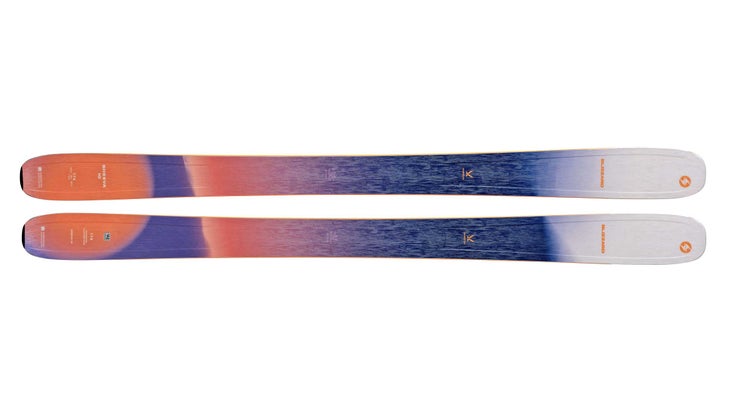
7. Blizzard Sheeva 10
$800 at REI $800 at Backcountry
Score: 6.95/10
Dimensions: 133.5-102-122.5 mm
Lengths: 156, 162, 168, 174, 180 cm
Turn Radius: 14.5 m (162 cm)
Weight: 1,640 g (162 cm)
Pros and Cons
⊕ Confidence-boosting
⊕ Light yet stable
⊕ Large size run
⊗ Chatters at high speeds
⊗ Doesn’t bust through crud like others
With solid scores across the board, the Sheeva 10 proves itself yet again to be a true all-rounder. When it came to the nuances of its personality, however, testers argued passionately about what, exactly, its best traits were.
Most applauded its huge sweet spot and friendly-for-all ethos, noting that it’s light, playful, quick, and responsive. Others, however, loved its strength and stiffness, deeming it capable of busting through crud and chop at high speeds. The takeaway behind these mixed messages? This is a ski that’s both easy and strong, a balanced and energetic ride that boosts confidence for all abilities in tricky conditions.
After an overhaul for the 2023-’24 season, the Sheeva 10 ranked No. 2 overall in last year’s test, a discrepancy that may be explained by conditions. Last year, testers skied light and soft snow at Sun Valley, whereas this year, they skied weird, wind-affected powder at Mt. Rose that made a few testers feel bucked around in the longer 174-centimeter length.
Still, for testers who favor energetic skis with personality over stiffer, damper planks, it rose to the very top of the pile. “A really nice blend of stability, predictability, liveliness, and fun,” summed up Outside Associate Gear Director Jenny Wiegand.
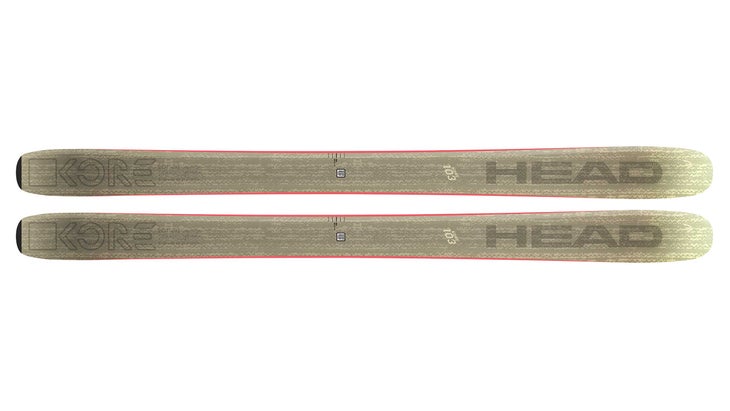
8. Head Kore 103 W
$749 at Head $749 at Ski Essentials
Score: 6.86/10
Dimensions: 132-103-123 mm
Lengths: 163, 170, 177 cm
Turn Radius: 13.8 m (163 cm)
Weight: 1,500 g (170 cm)
Pros and Cons
⊕ Light yet strong
⊕ Energetic
⊗ Chattery at high speed
⊗ Not heavy enough to bust through crud
The Kore line has long been revered for its strength-to-weight ratio, making it an excellent crossover, one-ski quiver for the backcountry and resort. Head’s secret sauce in the Kore 103 W is a lightweight caruba-poplar wood core reinforced with a layer of graphene—a super-strong, space-age carbon material that’s only one atom thick—in the tips and tails, and a carbon sandwich cap construction for added stability.
Testers have ranked the Kore 103 W among winners in this test for years, and not much has changed—in either the ski’s construction or in the starstruck feedback it elicits. At Mt. Rose, it proved itself again as a lively and energetic charger that danced through bumps and carved cleanly on the groomer back to the lift. It is forgiving enough for lesser experts, strong enough for high experts, and confident enough to transform the former into the latter.
It does fall short in set-up snow, where it deflects and loses snow contact, testers said. Though, that’s a fairly predictable side effect of its lightweight construction. Testers also mentioned it can get chattery at high speeds. Still, most wouldn’t hesitate to recommend this lighter-weight option to intermediates through experts looking for a user-friendly all-mountain tool.
“I was surprised at how smooth and stable she was for a ski with no metal, especially when carving on groomers,” said ex-racer Avery Pesce. “Super nice snow feel.”
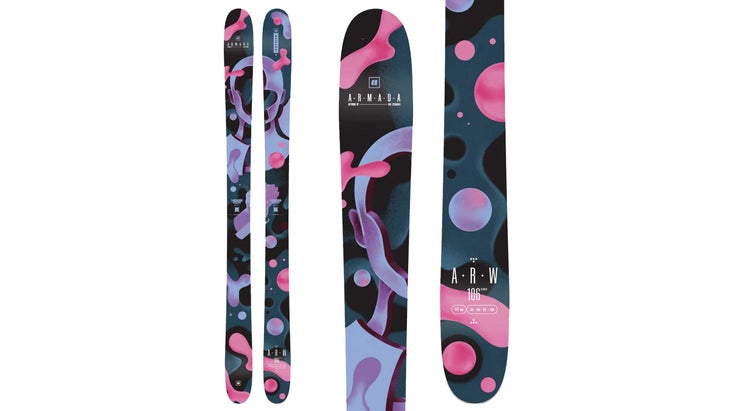
9. Armada ARW 106
Score: 6.76/10
Dimensions: 133-106-123 mm
Lengths: 164, 172, 180, 188 cm
Turn Radius: 19.5 m (172 cm)
Weight: 1,925 g (172 cm)
Pros and Cons
⊕ Poppy
⊕ Playful
⊗ Not reliable on ice
⊗ Floppy at high speeds
The all-new ARW 106 boasts a completely unique sidewall construction that Armada calls Wedgewall. Debuting in the narrower models of the line last year, the construction now appears in the ARW 106 and 112, with 3D-injected sidewalls that get thinner in the tips and tails. No other ski company has done this; usually, sidewalls are the same thickness down the entire length of the ski. This new method helps to make the ski grippier and more durable even at a lighter weight.
Judging by testers’ reactions, it works. Testers found the ARW (which uses the exact same construction as Armada’s unisex ARV) to be playful and easy to pivot, smear, and surf. That proved tremendously helpful when quickly scrubbing speed to avoid wind lips at Mt. Rose.
The ARW 106 is built to reward finesse over brute force, so heavier skiers who expect a directional ride may find they overpower it. Some testers also complained that it felt a little floppy at high speeds—earning it the lowest and second-lowest marks among skis on this list for hard-snow integrity and stability at speed, respectively.
But for those who want a fun and relaxed playmate, the ARW 106 is a solid choice. “I want this ski for Bridger Bowl—a resort with playful features where you need to dump speed quickly,” said Outside editor and ex-racer Kelly Klein.

10. K2 Mindbender 106C W
Score: 6.61/10
Dimensions: 138-106-127 mm
Lengths: 155, 162, 169, 176 cm
Turn Radius: 15.7 m (169 cm)
Weight: 1,770 g (169 cm)
Pros and Cons
⊕ Floaty in pow
⊕ Quick in bumps and tight terrain
⊕ Good value
⊗ Not as gutsy in crud
⊗ Nervous at speed
Oftentimes, less-than-favorable conditions make for a great ski test, because it becomes clear within two turns which skis make you feel confident that you’re not going to tomahawk down steep chunder. Such were the conditions for this year’s test at Mt. Rose, with windboard, wind lips, and sastrugi—but even so, it took testers a few runs to decipher the Mindbender 106C W.
It’s forgiving and playful, said some, but that came with a downfall of being nervous in crud. It’s floaty, said others, but at the cost of chattering on hardpack. All agreed, however, that if conditions were actually soft, which is what this ski is designed for, it would shred. “It’s not the most versatile, but it would be good for a 6- to 12-inch pow day,” said Courtney Harkins, director of marketing and communication for the U.S. Ski and Snowboard Team.
The Mindbender 106C W is made with a lightweight aspen wood core and a carbon fiber reinforcement that looks a little like a hair net stretched over the ski. The idea is that this alters the stiffness according to the location on the ski—more in the tip, less in the tail—to give it optimal energy and rebound. Most testers agreed the result is a well-balanced ski that’s accessible to intermediates and fun for experts, as long as conditions are soft.
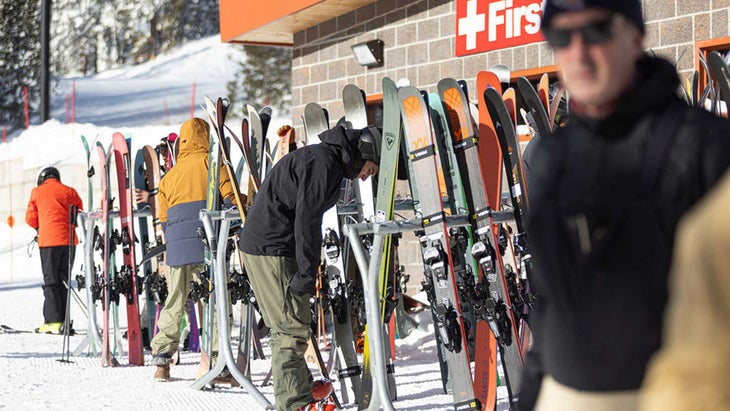
How We Test
- Number of skis tested: 13
- Number of testers: 13
- Testing location: Mt Rose, Nevada
- Average age of tester: 37
- Average height of tester: 5’5”
- Average weight of tester: 141 lbs
SKI has been running its annual ski test for decades now, but we’re always tweaking and perfecting the process. Last March, we invited a crew of seasoned industry professionals—ski instructors, ski shop employees, coaches, and former World Cup racers—to join us for a week-long gear test at Mt. Rose, Nevada, a lesser-known indie resort with amazing terrain.
The mission: jump on every pair of skis entered into our five categories (Carving, Frontside, All-Mountain, All-Mountain Wide, and Powder), put them through their paces all over the mountain, and then fill out a digital scorecard. Each tester noted their comments and impressions of how each pair of planks performed across various skill categories—from carving chops and crud performance to stability at speed and responsiveness.
Learn more: Understanding our SKI Test Scoring Criteria
We asked our crew of 27 testers to identify a ski’s primary strengths, its weaknesses, who it’s designed for, and what terrain and snow conditions it’s most adept at. At the end of the week, we had enough hard data on the 100-plus pairs of skis tested to make your head spin. We used it all to bring you these reviews of the best skis of the year.
When judging an all-mountain wide ski, we primarily assess how well it performs in deeper snow, be that fresh pow or days-old crud. Lucky for us, we didn’t have to make do with stale powder—we hit Mt. Rose right after the bomb cyclone that shut down Tahoe-area resorts for four days to give mountain ops teams enough time to clear the feet of snow that dropped on the area.
We did, however, contend with some seriously wind-affected snow that kept testers on their toes. The skis that impressed us the most with their ability to inspire confidence and hold steady in variable conditions made this list of the best women’s all-mountain wide skis of the year.

Meet the Testers
Kimberly Beekman
Age: 48 | Height: 5′4″ | Weight: 112 lbs
Kimberly Beekman has been testing skis and writing gear reviews for longer than she’d like to admit. She’s a former editor of SKI and freelance contributor to both SKI and Outside. She lives in Steamboat Springs with her wonderful daughter and terrible cat.
Kelli Gleason
Age: 38 | Height: 5’2” | Weight: 120 lbs
Formerly the manager and head hardgoods buyer for BootDoctors in Telluride, Colorado, Kelli Gleason is an expert on all things ski construction and performance. Gleason was raised on the ski slopes, and thanks to a ski racing background, she is an athletic skier with solid technical form. After racing, Kelli went on to compete on the Freeride World Tour. These days, she spends most of her time touring in the backcountry.
Erika Northrop
Age: 43 | Height: 5′9″ | Weight: 174 lbs
Northrop grew up skiing at Taos, New Mexico, from her home in El Paso, Texas. She has worked in the ski industry since college, bopping between Colorado and the Pacific Northwest before moving back to Taos to work as the area manager for Christy Sports ski shop.
Frequently Asked Questions
What Are All-Mountain Wide Skis?
All-mountain wide skis are slightly wider than typical all-mountain skis, with waist widths that hover between 100 and 110 millimeters. While they’re still versatile all-mountain skis, they cater more to soft snow and powder and less to groomer skiing than slimmer all-mountain skis.
All-mountain wide skis feature more rocker in the tip and tail and typically a larger turning radius. However, unlike all-mountain skis, all-mountain wides tend to include less (or no) metal in the core to keep the weight of the ski more manageable, even at bigger dimensions.
Who Are All-Mountain Wide Skis For?
All-mountain wide skis are better suited to skiers who primarily ski off-piste, and at resorts that see abundant snowfall. All-mountain wide skis generally handle powder and crud better than narrower all-mountain skis. However, all-mountain wide skis sacrifice edge performance, so skiers who care about making precise turns and carving on groomers occasionally should look to narrower all-mountain skis.
How Wide Is Too Wide for a Resort Ski?
Skilled skiers will be able to manage a wide ski (100-plus millimeters) in most conditions and will still be able to make these skis carve. But intermediate skiers still working on their skills may find all-mountain wide skis a lot of work to maneuver, especially in the types of conditions you’re likely to encounter at the resort. Learn more here.
What’s the Difference Between Men’s and Women’s Skis?
In truth, most skis are unisex and not gender-specific. Many brands produce each ski with the exact same construction technologies for both genders, but create two different top sheets to appeal to men vs. women. A handful of brands are making truly women’s-specific skis, where designers takes a woman’s physique and biomechanics into account when building the ski. For the most part, though, you can ski pretty much anything regardless of the ski’s stated gender. You just may want to choose a different length than someone of another gender would, depending on your height and skiing ability.
